Text
Jami Bell, Kidney Transplant Recipient and Scholarship Winner

Good evening. Thank you all for being here tonight. I am honored to be able to share my story with you and to thank you, from the bottom of my heart, for your caring, generosity and support for the Kidney Foundation of Ohio, the kidney community here in Ohio, and for me personally.
I was born with a birth defect, a kink in my ureter, which made it impossible for my left kidney to drain. After 18 months of crying, the doctors finally agreed with my mother that it was not colic and that something was very wrong. They did an exploratory surgery and followed it with an operation to remove my diseased left kidney. My right kidney was damaged during this time from all of the toxins; however, I was blessed that it lasted a lot of years. I had numerous infections throughout my childhood, as well as kidney stones in my early 20’s during Finals Week, that did significant damage. I crashed into dialysis in April of 2015.
To me, the question remains how a person who was a lifelong member of the kidney community could crash into dialysis. The fact is that even though I was educated on kidney infections, no one ever educated me on the symptoms of kidney failure. This is one of my advocacy passions. Everyone needs education, but members of the kidney community need specific education on how to know if your kidneys are in serious jeopardy.
During my 4 years, 8 months, and 3 days on dialysis (and yes, I definitely counted!), I wanted information to protect my health and my ability to receive a transplant. Kidney Foundation of Ohio supplied education that enabled me to get that call and get the transplant that changed my entire life. In addition, I received the Kidney Foundation of Ohio Educational Scholarship, which enabled me to go back to school and earn my degree. I am a 3-time scholarship award winner thanks to all of you! Your generosity to the Kidney Foundation of Ohio allowed me to return to school, use the time in my dialysis chair to study, and earn my degree. I am proud to say that I am now a Licensed Social Worker!
Your donations did not stop with me. They have had a ripple effect. I have given speeches to the kidney community, started an advocacy committee, provided education and support, and made my most important recommendation: You are your own best advocate. Use your voice! Using my education as a resource for the kidney community, I have drafted fact sheets, policy briefs, and written testimony for members of both the federal and state legislatures as well as attending meetings with those legislators.
I wrote a letter to one legislator, who wrote me back with concern that if too many people receive transplants, dialysis centers will be forced to close. I researched how many people go on the waitlist every single day, how many people start dialysis every year, and how many transplants occur every year on average which showed that there was no danger to dialysis centers. In a response letter, I included this information, along with a personal explanation of how dialysis impacted my life.
My reason for telling you this is to show you how your generosity, how your donations, have a ripple effect. Your generosity enabled me to get an education, and during my internship, I was now in a position to be, as my field instructor stated, integral to the passage of the Ohio Living Donor Protection Act. That was all thanks to you for empowering the Kidney Foundation of Ohio which enabled them to empower me. This gave me the opportunity to send your generous donations rippling throughout the state of Ohio and beyond! And I am just one beneficiary. From the bottom of my heart, I thank you!
Jami shared her story at the 2024 Gala.
0 notes
Text
What is a Kidney Swap?
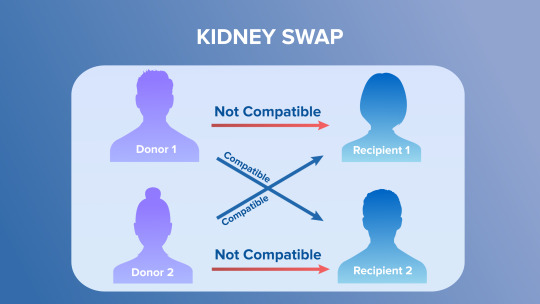
There are two options for a person on the kidney transplant wait list. A transplant from a deceased donor, or from a living donor. Only one healthy kidney is needed to replace two failed kidneys; a living donor can have one of their kidneys removed and have it transplanted into a recipient whose kidneys no longer function.
If an individual waiting for a kidney transplant finds a living donor, but the donor isn't a compatible match for the recipient, the transplant team may offer the opportunity to participate in a paired kidney exchange, also known as a kidney swap.
There is a program through the National Kidney Registry to help arrange swaps. If a donor is not a match for the person they want to donate to, they may be a match for someone else on the waitlist. That other individual waiting may have a person willing to donate who is not a match for them. They can swap who will donated a kidney to who, so both individuals can receive a kidney transplant.
Additional questions? Contact your transplant center, or call Kidney Foundation of Ohio at 216-771-2700.
0 notes
Text
Loren's Transplant Journey
Loren was on dialysis for 5 years and 1 day, until she received a kidney transplant as part of a kidney swap in March of 2022.
Loren is a Type 1 diabetic and started to experience protein in her urine in her early 20s, but it wasn’t until her 30s that she started to see a nephrologist (kidney doctor). She noticed she was gaining a lot of weight due to fluid retention. She was hospitalized and put on a medication to reduce the fluid in her body. Unfortunately, her kidney function declined as a result.
She began in-center hemodialysis three times a week. It was not an easy adjustment for Loren. She was hypotensive, her initial fistula wasn’t viable, and she had no energy. However, this was her best option aside from a transplant and she knew that.
Although she started looking into getting a kidney transplant when she started dialysis, she only wanted to receive a deceased donor kidney. Loren was on the transplant waitlist for three years before the realities set in. She was on the list to receive a pancreas/kidney transplant (because of her Type 1 diabetes), which is often a shorter wait time, but she had received two blood transfusions in the past which worked against her.
Her family eventually convinced her to seek out a living kidney donor. Loren did not consider a living donor at first because in her mind it felt selfish. She now realizes what a misconception that was.

Loren and her sister
Loren’s sister was tested, and was a match, but found out she had a condition that precluded her from donating. They created a Facebook page to spread the word, and within two months someone came forward to get tested.
The woman who came forward, Katie was a former student of Loren’s father – he’s a former high school English teacher. Katie was a match for Loren, but she was also a match for another recipient, and that individual's donor was a match for Loren, so the four ladies took park in a paired kidney donation (kidney swap)! Read more about Katie and her experiencing donating a kidney.

(l to r) Loren, Katie, and the other two women who participated in the "kidney swap"
The kidney that Loren received was from a woman who always knew she wanted to donate her kidney. Her grandmother received a life-saving kidney transplant and she wanted to donate one in her honor.
Loren says she vowed long ago that if she was lucky enough to get a kidney transplant, she’d continue to show her gratitude by helping to educate others. “If there is anything I can say or do to help someone feel better about making the decision to get a transplant, I want to do it”.
How did she feel post-transplant? “Night and day. I have so much energy. I feel stronger and am building muscle finally. I can eat things like cheese and nuts, which are high in potassium. I wasn’t able to eat these things before”. Loren used to be out of commission for a full day, if not two, after receiving dialysis. She hadn’t even realized her energy was so low until after the transplant.

Loren, Katie, and their significant others at the Kidney Foundation of Ohio 31st Annual Gala
What would she tell someone who is hesitant about receiving a kidney from a living donor? “If there’s a living donor out there and they’re willing [to donate their kidney], and they’re a match, let them. They’re not making a light-hearted decision either. It’s something they want to do.”
Hear more from Loren, and other transplant recipients, in Roadmap for Kidney Transplantation: Part Three.
0 notes
Text
Grateful for the Gift of Life
When Larry first discovered his kidney disease had reached Stage 4, he was in denial. He had been in generally good health his whole life and thought he could “fix” this. He never wanted to get a kidney transplant.

Larry with his wife and granchildren
Although he’d been in good health, Larry had known since the age of five that he had some sort of hereditary kidney nephritis. It wasn’t until his mid-40’s that Larry found out he has Alport Syndrome. He had noticed some exhaustion, but figured it was because of his physical job, and a side effect of getting older. The realization he was in Stage 4 of kidney disease was a shock.
Larry learned about all the dialysis options available. He became fearful; worried he’d have to stop working. He couldn’t imagine not being able to provide for his family through his work, so he was determined to find a living kidney donor before he’d have to start dialysis.
Where to even begin? These were Larry’s first thoughts on finding a donor. He knew living donors come from family members a lot of the time, but because of the history of Alport Syndrome in his family, nobody was eligible to donate.
He felt fortunate he didn't have to go to any great lengths. A longtime friend, Daleen, heard Larry’s story and knew she wanted to help. Daleen was the first and only person to get tested and was, incredibly, a perfect match.
At this point, it was up to Daleen as the donor to schedule the surgery at her convenience. It was several months from when they found out it was a match to when the transplant occurred on August 18, 2020.
Two days after surgery, Larry began feeling a lot of pain, but he cannot speak highly enough of everyone at Cleveland Clinic who cared for him. He says it was a rough couple of weeks, but knowing how he feels today he cannot imagine the experience going any differently.
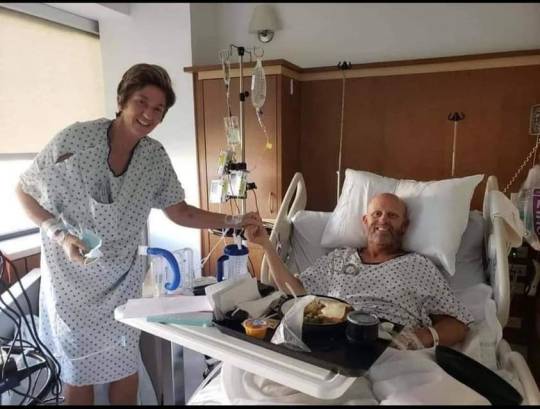
Larry (right), and his kidney donor, Daleen (left)
Larry feels lucky to have had an incredible support system in his wife, two daughters, his parents, and friends. He says the experience would have been completely different without that support.
What does Larry want to share after going through this experience? “For those hesitant about transplant, it’s worth it! I didn’t realize how bad I felt, knowing how wonderful I feel now”.
Larry shares his story because he wants people to ask him about it. He wants people to become a living donor. He feels so grateful to Daleen for the incredible gift she gave him, and treats himself the best he possibly can to honor that gift.
Hear more from Larry, and other transplant recipients, in Roadmap for Kidney Transplantation: Part Three.
0 notes
Text
2023 Scholarship Recipients
The Kidney Foundation of Ohio Educational Scholarship was designed to help a deserving kidney patient, or child of a patient, achieve their academic goals and complete a college education or technical school. We are excited to highlight the stories of the 2023-2024 recipients.
Amanda Vesely

Amanda was diagnosed with Chronic Kidney Disease (CKD) at 15 years old. Amanda recounts that after her diagnosis she became very interested in the disease, and the organ in general. Going into her junior year of high school she knew she wanted to become a “trusted, well-rounded, and reliable nephrologist”. She wants to work on a transplant floor or in a dialysis center. Since she has already been on the patient side of that experience, she hopes to make a difference for her future patients.
Amanda is a junior at Kent State University where she’s earning her Bachelor’s Degree in Biology Pre-Med. She currently works as a Nurse’s Aide, and is described as hard-working, patient, and compassionate. Her boss says “she is always putting the residents’ needs before her own and is constantly doing something to better the residents, facility or staff, even if that means late night Dunkin’ runs for our midnight nurses! She is selfless and puts a heavy emphasis on her role as a State Tested Nurse Aid (STNA).”
Jacob Cordiak
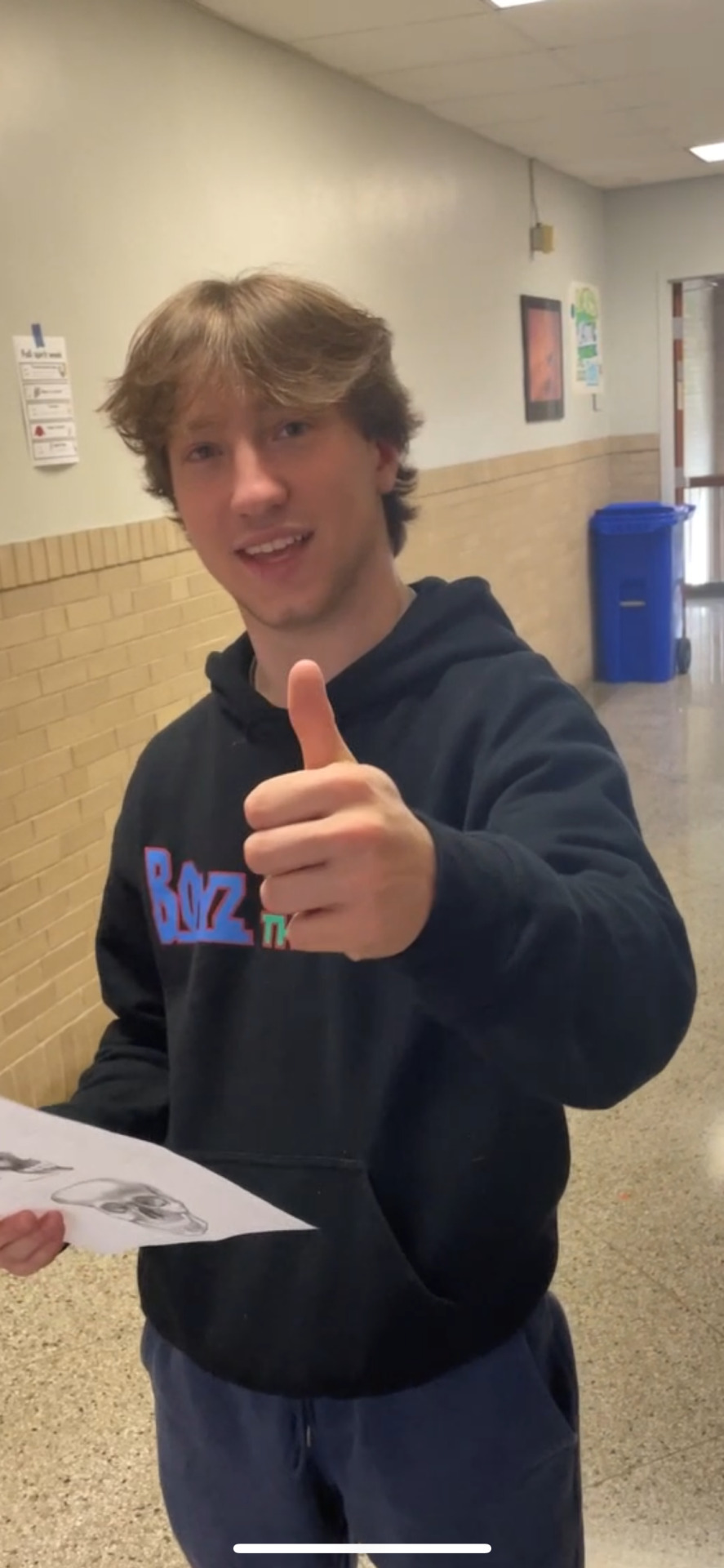
Jacob was diagnosed with End Stage Renal Disease (ESRD) unexpectedly at 16 years old, and started dialysis the next day. After 18 months on dialysis, he received a living-donor kidney transplant from his best friend’s sister. Unfortunately, 4 months later he was back in the hospital for four weeks. His creatinine levels were fluctuating drastically day to day, and the doctors did not know why. Eventually, his levels stabilized and he was sent home.
A week later Jacob was back because he was experiencing low grade fevers which turned into high grade fevers. Once readmitted, they immediately knew something was wrong with Jacob’s heart and he was transferred to the Pediatric Cardiology ICU. After testing it was determined Jacob had Myocarditis. He spent the following month in the hospital.
Jacob is home now, and doing physical therapy. He will be attending University of Cincinnati to study Nursing. Jacob is described by his doctors, coaches, and teachers as a beacon of positivity, and as displaying maturity and composure beyond his years.
0 notes
Text
Thriving After Transplant
Boyd was diagnosed with primary sclerosing cholangitis (PSC) – a liver disease - at 20 years old. He was caught completely off guard, having no idea where the illness came from. He felt scared and humbled; his entire lifestyle had to change. He found out a year after being diagnosed that he would need a liver transplant.

For the next five years, he tried to stay as busy he could to keep his mind off of how sick he was. Finally, in November of 2002 – the Cleveland Clinic called and said they had a liver from a deceased donor. After a few months, he felt back to normal. Having put off going to school while waiting for a transplant, he enrolled in classes part-time at Tri-C, while working full-time, and ultimately graduated from Ursuline in 2017.
Everything seemed on track until abnormal blood work came back from one of his monthly visits. After receiving a kidney biopsy, Boyd was diagnosed with End-Stage Renal Disease (ESRD). While the medications he was taking were working to keep his liver healthy, they were toxic on his kidneys.
Feeling in denial at this point, it wasn’t until he finally noticed how much weight he’d lost – nearly 25lbs – that it hit him. Boyd ended up going to the hospital in the summer of 2021 and immediately began 24-hour dialysis in the emergency room. The doctor had to do a double take at his BUN levels (almost 200) and wasn’t sure how he was even still alive.
In Boyd’s words, “I never want to feel like I felt then again.” His eyes were opened when he started dialysis and began feeling better. He could see clearly now and felt blessed and grateful to be alive. He was fortunate to be surrounded by a great support system – his wife and daughter, his friends, the care team at the hospital, and his employer.
It was never a question in Boyd’s mind to get on the transplant waitlist. Why? “Do you want to be tied to this [dialysis] the rest of your life? I sure don’t.”
After two and a half years on the waitlist, Boyd received a kidney transplant on May 2, 2022! He is grateful to be back at work, and no longer tied to dialysis. He feels healthier, stronger, and happy to continue living life with his wife and daughter.
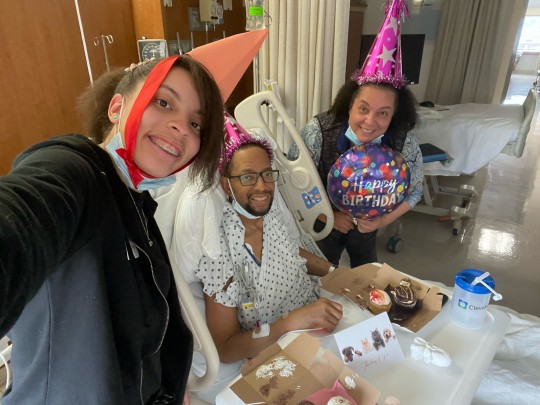
Boyd said it’s been interesting to watch healthcare change over the past 25 years – since his liver transplant – how far technology and innovation have come in transplant. He thought more people would be informed on the benefits, but there’s still people who are apprehensive, that’s why he continues to share his story.
Hear more from Boyd, and other transplant recipients, in Roadmap for Kidney Transplantation: Part Three.
0 notes
Text
Gloria Harris-Isom, Kidney Transplant Recipient
Gloria Harris-Isom is a two-time kidney transplant recipient, and participated in our Roadmap for Kidney Transplantation video series. She also attended the Kidney Foundation of Ohio 31st Annual Gala to share her story.

At 43 years old, Gloria was experiencing swelling in her feet, and through bloodwork and a process of elimination she was diagnosed with glomerular nephritis and nephrotic syndrome.
She was shocked. As a nurse herself, and with what she knew of her family history, she made an effort to live a healthy lifestyle. “Why me?” was her reaction. She felt she had “done everything right”, and was overwhelmed.
Her doctors thought it would be something she would just need to manage for awhile. They felt the chances of her going into kidney failure were rare. She took medications and modified her diet, but bloodwork eventually started to show signs of kidney failure. Her nephrologist informed her she would need a kidney transplant.
Gloria wasted no time reaching out to family and friends to see if they would get tested to be a living donor. Her brothers volunteered to be evaluated and, although both were matches, one was a better match than the other.
She received her first transplant at University Hospitals Transplant Institute in 2002, three years after finding out about her kidney disease.
youtube
11 years later, Gloria tore her aorta while doing a sit up. She woke up and was on dialysis. She was told her kidney had failed.
After doing in-center dialysis for a few weeks, she made the decision to move to in-home dialysis. She felt it provided her more autonomy, a more normal lifestyle. She was still able to work and travel if she wanted. In-home dialysis also provides near normal kidney function, and she felt comfortable with the process due to her nursing background.
Gloria continued on dialysis for two years until her second transplant in 2015, which took place at Walter Reed Military Medical Center. Gloria is in the military so she was listed at the VA and three other transplant centers. Her second kidney transplant came from a deceased donor - a young soldier who lost his life. She received his left kidney, and remains friends with the woman who received his right kidney.
How is she feeling today? “The transplants have afforded me the ability to enjoy life to the fullest, the best I can”. While she still has to be considerate of everything she does, she is able to work part-time, travel, and be with friends.
Hear more from Gloria, and other transplant recipients, in Roadmap for Kidney Transplantation: Part Three.
2 notes
·
View notes
Text
Donating Your Kidney
Is a family member or friend in need of a kidney transplant? Do you want to get tested to donate your kidney? Living kidney donors can be family members, friends, neighbors, co-workers, or even altruistic strangers. This type of donation accounts for about one-third of all kidney transplants performed in the United States.
There are two options for a person who is on the wait list for a kidney transplant. They can receive a kidney from a living donor, or from a deceased donor. A living donor kidney transplant is when a kidney is removed from a donor, and placed into a recipient whose kidneys no longer function properly. Only one donated kidney is needed to replace two failed kidneys.
In Ohio, the average wait time for a deceased donor kidney is three to five years. The timing is considerably shorter for a living donor kidney. Once a compatible living donor is found, surgery can be scheduled after testing and evaluation is complete, no need to wait for a deceased donor kidney to become available.
Both the recipient and the living kidney donor will be thoroughly evaluated to determine if the donor's organ is a good match. There are three main tests that determine if you and the donor are compatible:
Blood typing. This test measures blood antibodies that react with different blood groups.
Tissue typing. The blood of the recipient is tested to see if their genetic make-up is close to the donor's. It does not need to be a perfect match, but it is better for a more successful outcome.
Cross-matching. This is a way for the transplant center to test the recipient’s blood against a donor's blood to make sure they are fully compatible.
If a living kidney donor getting tested isn't a compatible match, the transplant team may offer the opportunity to participate in a paired kidney exchange, also known as a kidney swap. If a donor is not a match for the person they want to donate to, they may be a match for someone else. That person may have a donor who is not a match for them. They can swap kidneys.
The transplant operation takes on average between two and three hours. Usually, the recipient and donor surgeries happen at the same time, in separate operating rooms. Recovery time in the hospital is typically one to three days. Donors are often able to resume normal activities as soon as two to three weeks after the procedure.
As with any surgical procedure, there are also risks, both for the donor and recipient. Living kidney donors go through extensive testing to ensure they are in the best health to undergo a major surgery and that the donation process will not harm their health in any way. The transplant team will carefully outline and discuss all the potential risks of the transplant.
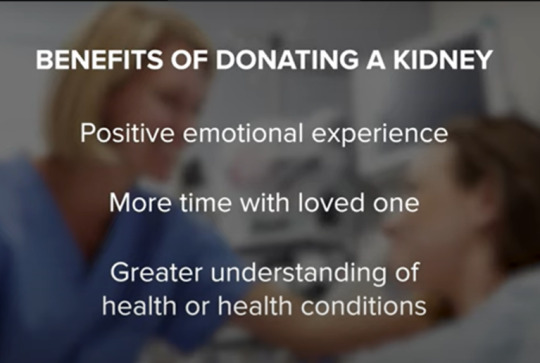
Kidney donation has a profound impact on the lives of donors. Each donor has their own unique experience as they go through the journey of donating a kidney. While there are countless benefits for the recipient, there are positive aspects for the donor as well:
Positive emotional experience. This includes feeling good about improving another person’s life.
More time with loved one. By donating a kidney, you and the donor are gifted more quality time together.
Greater understanding of health or health conditions. The extensive medical testing during the evaluation can provide the donor with a comprehensive picture of his or her physical health.
The decision to donate an organ must be completely voluntary and free from pressure. It’s illegal to sell or buy human organs and tissues in the United States. The transplant team asks the donor every step of the way if they still want to move forward with the transplant. They can decide to not follow through at any point during the process.
youtube
Watch Roadmap for Kidney Transplantation: Part Two to learn more from the perspective of a living donor.
If you are interested in getting tested to be a kidney donor for someone on the wait list, you’ll need to contact the transplant center or centers where they’re listed.
Interested in being an altruistic living kidney donor? Contact a transplant center to start the process.
Additional questions? Contact Kidney Foundation of Ohio at 216-771-2700.
1 note
·
View note
Text
Benefits of a Living Kidney Donation
There are two options for a person on the kidney transplant wait list. A transplant from a deceased donor, or from a living donor. In Ohio, the average wait time for a deceased donor kidney is three to five years. The timing is considerably shorter for a living donor kidney. If you pursue kidney transplantation as a treatment option, your transplant team will work with you to determine which option is right for you.

A living-donor kidney transplant offers many advantages for people with kidney disease.
Wait times are reduced from years to months. There is less time spent on a wait list, which could prevent possible complications and deterioration of health.
Overall outcomes are better. There are better short and long term survival rates.
Kidneys begin working faster. Because the transplanted organ comes from a healthy, living person, your time spent recovering from a kidney transplant is often shorter.
Potential avoidance of dialysis, if it has not been initiated.
Donors and recipients can plan the surgery for a time that’s convenient for them. This eliminates the rush and unknowns tied to being on the transplant waitlist
As with any surgical procedure, there are also risks, both for the recipient and the donor. Living kidney donors go through extensive testing to ensure they are in the best health to undergo a major surgery and that the donation process will not harm their health in any way. The transplant team will carefully outline and discuss all of the potential risks of the transplant for both the recipient and the donor.
Both individuals will be thoroughly evaluated to determine if the donor's organ is a good match for the recipient. There are three main tests to make this determination:
Blood typing. This test measures blood antibodies that react with different blood groups.
Tissue typing. The recipient’s blood is tested to see if their genetic make-up is close to the donor's. It does not need to be a perfect match, but it is better for a more successful outcome.
Cross-matching This is a way for the transplant center to test the recipient’s blood against a donor's blood to make sure they are fully compatible.
If your living kidney donor isn't a compatible match, your transplant team may offer you and your donor the opportunity to participate in a paired kidney exchange, also known as a kidney swap. If a donor is not a match for the person they want to donate to, they may be a match for someone else. That person may have a donor who is not a match for them. They can swap kidneys.
If the donor successfully completes a medical, surgical and psychosocial evaluation, they can undergo the removal of one kidney. The operation takes on average between two and three hours. Usually, the recipient and donor surgeries happen at the same time, in separate operating rooms. Recovery time in the hospital is typically one to three days.
To learn more, watch the Roadmap for Kidney Transplantation video series, or contact the Kidney Foundation of Ohio at 216-771-2700.
0 notes
Text
Lifetime Achievement Award, Dr. Haifa Hanna
Dr. Haifa Hanna was presented the Lifetime Achievement Award at the 31st Annual Kidney Foundation of Ohio Gala.

Dr. Hanna was born and raised in Idlib, Syria. She went to medical school at the University of Damascus, in the capital of Syria, graduating in 1964. The following year, she moved to Cleveland, OH and completed three years of training in internal medicine.
During her training, Dr. Hanna was introduced to peritoneal dialysis treatment, including catheter insertion, for acute kidney failure by Dr. Bill Cummings, the only community nephrologist in the area at the time. From 1968-1970, she was fortunate to be trained in nephrology by two outstanding mentors, Dr. Satoro Nakamoto and Dr. Robert Eckel.
In 1970, Dr. Hanna started hemodialysis treatments at Huron Road Hospital. Although she didn’t always have a lot of support, and difficulties arose, she found these treatments were becoming increasingly needed in the community. She received assistance from Dr. Eckel at this time who lent her dialysis machines and technicians.
Dr. Hanna went on to establish ambulatory acute hemodialysis in community hospitals in Richmond Heights and Brentwood (what is now South Pointe Hospital), and later LCH West, by training a technician and providing him a machine.
During the 1980s, she had great interest in peritoneal dialysis as a first line treatment chronic kidney failure. Dr. Hanna collaborated with Dr. Martin Schreiber at Cleveland Clinic to have patients trained. She then went on to establish a community dialysis unit that ran for over 20 years. After 47 years in practice, Dr. Hanna retired in 2018.
Dr. Hanna has been a member of the Kidney Foundation of Ohio Medical Advisory for more than 25 years and serves on the Foundation’s Scholarship Committee. Dr. Hanna and her husband, Dr. Michael Hanna have two sons, who are also both doctors.

Dr. Richard Fatica, Dr. Michael Hanna, and Dr. Haifa Hanna
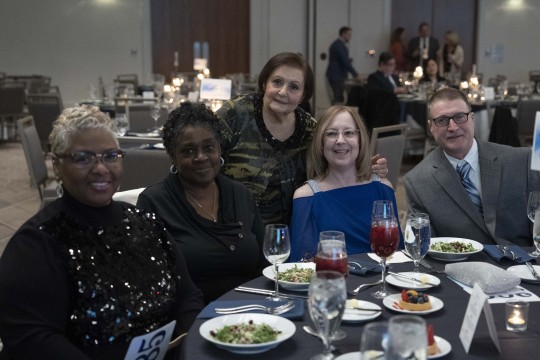
Dr. Hanna with her former patients and kidney transplant recipients, Corlette Courtland and Brenda Peters, and their guests.
0 notes
Text
Dr. Mahboob Rahman, 2023 Person of the Year
Established in 1992, each year, the Person of the Year award is given to an individual or partner organization for their outstanding leadership and contributions in the field of nephrology, and their dedication and service to the mission of the Kidney Foundation of Ohio.
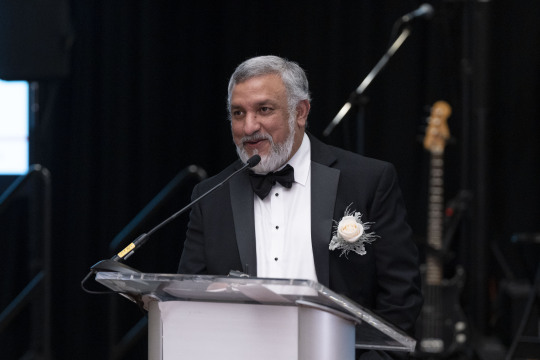
The 2023 Person of the Year Award was presented to Dr. Mahboob Rahman at the 31st Annual Kidney Foundation of Ohio Gala.
Dr. Rahman is the Chief of the Division of Nephrology and Hypertension at University Hospitals Cleveland Medical Center, and a tenured Professor of Medicine at Case Western Reserve University. He holds the Peter B. DeOreo, MD, Endowed Chair in Nephrology and Dialysis. Dr. Rahman also serves as the Vice Chair of the Department of Medicine, and as a Staff Nephrologist at the Louis Stokes Cleveland VA Medical Center.
He has practiced in all aspects of General Nephrology in the Cleveland area for more than 25 years, with a focus on care of patients with complex Hypertension. He has received multiple awards recognizing his clinical expertise, including the University Hospitals Distinguished Physician award, Master Clinician in the Department of Medicine award, and has been listed among the Top Doctors in Cleveland Magazine for several years.
Dr. Rahman has served in a leadership role in many large multi-center clinical trials, and has over 200 publications in the areas of hypertension and chronic kidney disease. His research has been funded by the National Institutes of Health (NIH) continuously since 2001. He serves on many national and
international committees, and in professional societies, including his role as the Associate Editor of the Clinical Journal of the American Society of Nephrology.
He is active in teaching students, residents and fellows, and mentoring junior faculty. He received the Scholarship in Teaching award from Case Western Reserve University. Having lived most of his adult life in this area, Dr. Rahman is a passionate Clevelander, and a dedicated fan of the Cavaliers, Guardians (and yes, even the Browns!).

Dr. Mahboob Rahman and his family at the 31st Annual Gala.
During the award presentation at the 31st Annual Gala, Dr. Mirela Dobre, nephrologist at University Hospitals Cleveland Medical Center, introduced Dr. Rahman. Read parts of her introduction below.
“As a leader in the Nephrology community, an extraordinary physician, researcher, mentor, collaborator and friend, Dr. Rahman has dedicated his career to advancing the field of nephrology through his groundbreaking research, countless mentoring activities and innovative approach to patient care.
I would say, and I believe many of you here tonight would agree, that a characteristic that clearly distinguishes Dr. Rahman is his innate ability to bring justice to the table in pretty much all circumstances, and to meet everyone where they are. This is a personality trait that makes him a talented leader and we are fortunate to have him as our Chief of Nephrology at University Hospitals.
Dr. Rahman has been at the forefront of hypertension and chronic kidney disease research for over 20 years, working to develop new diagnostic and therapeutic approaches to improve the lives of patients with kidney diseases. Through innovative epidemiologic studies and clinical trials tackling hypertension and cardiovascular diseases as the most prevalent and challenging complications facing our patients, Dr. Rahman’s work has touched countless lives and has made a significant impact on the health and well-being of patients across the country and abroad. His research contributions have earned him the respect and admiration of peers, both in academia and in the medical community at large.
It is said that a teacher’s work is judged by the achievements of their scholars. In that regard, Dr. Rahman is an extremely accomplished professional, having trained numerous students, residents and fellows who are now well established in their respective academic fields. I have yet to encounter someone who has set as personal, top-priority goal, the professional advancement and career development of those he manages.
We look forward to witnessing the incredible undertakings he will continue to pursue in the years to come.”

Dr. Mirela Dobre presenting the 2023 Person of the Year award to Dr. Mahboob Rahman.
0 notes
Text
What To Know: Kidney Transplant FAQ
The kidney transplant process can be long and difficult, with a lot to think about. It is encouraged to get on the transplant waitlist as quickly as possible. Asking questions can help you determine if a transplant is a good fit for your lifestyle.

DO I NEED A SUPPORT SYSTEM?
A kidney transplant is major surgery and a support system plays a vital role before, during, and after transplantation. Both physical and mental support can be provided by a spouse or partner, family, or friends. This is a journey that someone cannot do alone.
WHAT DOES IT COST?
What you are required to pay depends on your insurance coverage. Medicare covers about 80% of costs associated with a transplantation. Private insurance and Medicaid may cover some costs as well. Multiple insurances can be used together to cover more of the expenses. Your social worker, transplant center and financial coordinator will help figure out the exact cost. While it can be an expensive process, transplant are obtainable with insurance.
HOW DO I FIND A LIVING DONOR?
One of the best ways to find a living donor is by sharing your story. Talk to friends, family, or coworkers about what you are experiencing and how they can help. Share your story at work, in your place of worship, on social media or any other place where you can reach others. Your transplant team can assist in what information is and is not beneficial to communicate to others.
WHAT IS LIFE LIKE AFTER TRANSPLANT?
A kidney transplant can feel like a second chance at life. It’s important to know that a transplant is a treatment option, not a cure. You will need to take care of your new kidney with anti-rejection medications and maintaining a healthy lifestyle. Your transplant team will provide directions for how to care for your body after surgery. You’ll likely start returning to normal activities within a month after your transplant, with more freedom to do what you enjoy.
The sooner you start the process to receive a transplant, the better your long-term health outcomes. You can go through this process at one, or multiple, hospitals. See a full list of transplant centers in Ohio here. Watch the Roadmap for Transplantation series on YouTube to learn more.
2 notes
·
View notes
Text
Stops on the Roadmap for Kidney Transplantation
A three-part video series was created with the goal to educate kidney patients on the benefits associated with getting listed for a kidney transplant, and to answer questions about the process. In the Roadmap for Kidney Transplantation: Part One, you’ll hear from a transplant nephrologist and a transplant coordinator who help support patients before and after a kidney transplant. They discuss the process to receiving a kidney from a living or deceased donor.

STOP #1: REFERRAL
You must be in at least Stage 4 Chronic Kidney Disease to be referred for a kidney transplant.
A referral call to a transplant center can be made by the patient, a primary care doctor, or dialysis unit.
Health records will be requested, and there will be an evaluation of your health insurance and financial coverage (without insurance, the transplant process cannot move forward).
STOP #2: EDUCATION
Once referred, education begins:
Exploring transplant options - living donor or deceased donor
What it’s like to be on the transplant waitlist
What the hospital stay is like during the transplant surgery
What life can be like after transplant
After the education process, you’ll sign a consent form that you want to
continue the process. You can change your mind at any time.
STOP #3: TESTING & EVALUATION
Many tests will be done to ensure your overall health, and that a transplant is a safe and helpful option for you.
Tests may include: CT scan, cancer screening, and dental evaluation
STOP #4: SELECTION COMMITTEE
Your health test results are evaluated by a team of transplant professionals. If approved, you’re added to the waitlist.
STOP #5: WAITLIST
Once on the waitlist, you are waiting for a deceased donor kidney to become available. Average time on the waitlist is 3-5 years.
Communication with your transplant team continues during this time.
Time on the waitlist can be reduced if you find a living kidney donor.
STOP #6: RECEIVING NOTICE
The call that a deceased donor kidney is available could come any day, at any time, so stay ready and accessible.
A deceased donor kidney must be transplanted within 1-2 days.
You can say no to a kidney at any point, and you won’t be removed from the waitlist.
Watch the Roadmap for Kidney Transplantation: Part One to learn more details about each stop in the process. View a PDF version of the above information here. Questions? Contact Kidney Foundation of Ohio at [email protected] or (216) 771-2700.
0 notes
Text
A Q&A with Incoming Board Chair, Sheri Beck-Eyssen
Sheri Beck-Eyssen has served as a volunteer, and member of the Kidney Foundation of Ohio (KFO) Board of Directors, for nearly 20 years. In 2023, she will serve as the Chair of the Board of Directors. We asked Sheri a few questions to learn more about her, her involvement with KFO, and her hopes for the future of the organization as she steps into leadership.
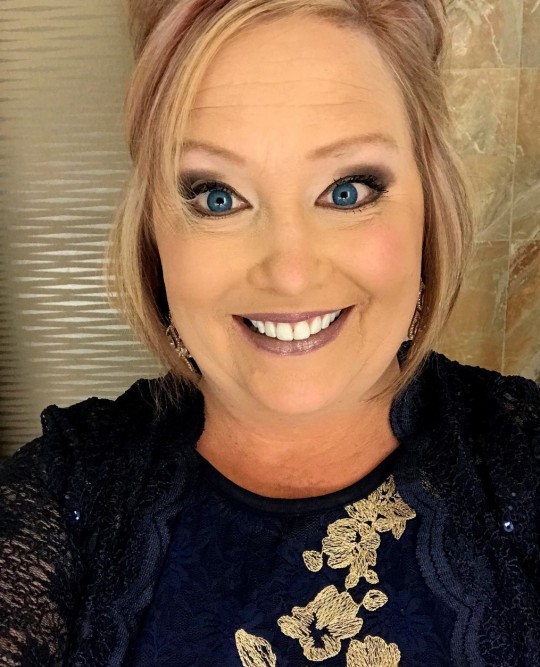
KFO: How and why did you get involved with the organization?
Sheri: I have been involved 17 years and counting with the Kidney Foundation of Ohio. The Kidney Foundation of Ohio was at an event I was being honored at for the Rainmaker of Tomorrow at the Cleveland Clinic Intercontinental. The KFO had a booth at the event promoting their mission and sharing insights. I knew then the KFO mission, values, and goals of the KFO were in alignment with my passion to help others and make a difference. I was a kidney patient and now a transplant recipient, and my hunger to be part of such a wholesome organization was exactly the right fit. I wanted to make a difference in lives of those struggling with kidney ailments and to educate others on the benefits of transplantation -was a match made in Heaven. My passion continues with the KFO and the amount of improvement and positive change I have seen over the years has been nothing short of amazing.
KFO: What is your favorite KFO activity or event?
Sheri: I value all the fundraising events the KFO puts on and particularly the events that meet families in the right places to take part in helping drive donations. The golf outing and the harvest walk are likely my top favorites because it draws camaraderie and fellowship at a different level.
KFO: What have you enjoyed about being on the KFO Board of Directors thus far?
Sheri: As a Board member for several years, I appreciate and value the transparency and networking with every board member. It is truly enlightening to see and meet so many talented and brilliant people aiming to make a difference to impact the community, its people, and drive the importance of giving back. The different insights and various professional roles of the board members help to drive the mission forward and to continually grow the organizations donations.
KFO: What are you most looking forward to as Chair?
Sheri: I am looking forward to being the Chair for the next two years to drive progress toward an even better organization striving for even more growth in donations, endowments, and charitable offerings. I would love to see more growth in fundraising efforts, consider new and different opportunities for additional giving, and more importantly the ability to influence helping even more patients in the future. There are so many opportunities to make positive change as the Chair and I hope I can make a footprint which will make a lasting impression.
Interested in getting more involved as a volunteer for Kidney Foundation of Ohio? Contact Annette at [email protected] or (216) 771-2700, or visit our website to learn what opportunities are available.
0 notes
Text
An Advocate for Kidney Patients
Elizabeth Oldham learned she had Chronic Kidney Disease (CKD) in 2018. Since then, she is learning everything she can in order to manage the disease. She knew she was at risk because of a family history of chronic disease, and her higher likelihood of developing CKD as a Black woman. However, Elizabeth lives a vegan lifestyle and is proactive in her healthcare journey, which she is hopeful will keep her from developing end-stage renal disease, and off dialysis, as long as possible.
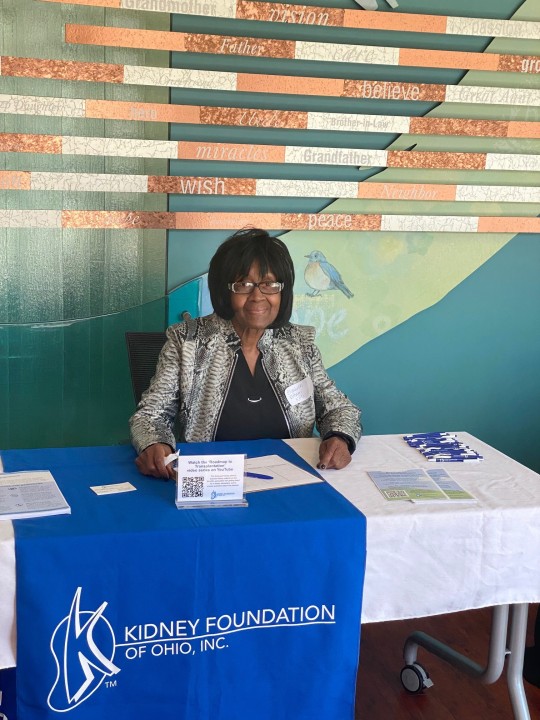
Elizabeth attended a community health fair on behalf of Kidney Foundation of Ohio.
While attending an educational class at a dialysis unit, Elizabeth received a pamphlet from Kidney Foundation of Ohio. She was inspired to get more involved with our educational offerings and began attending learning series sessions and World Kidney Day events. Then, in 2022, she took a step further and became a volunteer, assisting in passing out resources at community health fairs.
Elizabeth feels blessed to have more resources at her disposable than a lot of individuals with kidney disease, so she wants to give back to the kidney community. Aside from volunteering with KFO, her work has included helping to get the Living Donor Protection Act passed, writing articles for local news outlets, and serving on committees for national kidney organizations.
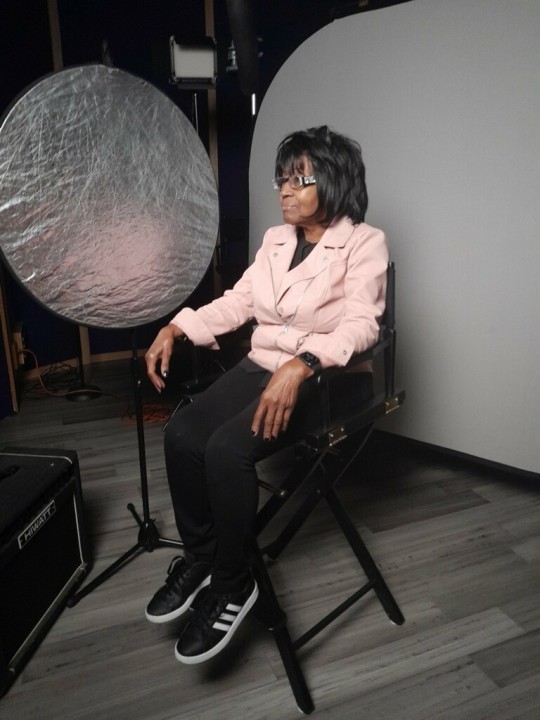
Elizabeth spoke in a video for Cleveland MOTTEP promoting COVID-19 vaccinations.
Since a very young age, Elizabeth and her family have been committed to community service, and education. Her passion for education on early disease detection is admirable, and we are thankful to have Elizabeth as a kidney patient advocate and volunteer. In her free time she is an avid reader who loves to collect old novels, go vintage shopping, and watch old classic films.
Interested in getting more involved as a volunteer for Kidney Foundation of Ohio? Contact Annette at [email protected] or (216) 771-2700, or visit our website to learn what opportunities are available.
3 notes
·
View notes
Text
Roadmap for Kidney Transplantation
A three-part video series was created with the goal to educate kidney patients on the benefits associated with getting listed for a kidney transplant, and to answer questions about the process.
Video #1 - Kidney Transplantation 101
Hear a transplant nephrologist and transplant coordinator give an overview of the transplant process including referral, testing & evaluation, and getting on the waitlist.
youtube
Video #2 - Living Kidney Donation
Living kidney donors can be family members, friends, neighbors, co-workers, or even altruistic strangers. This type of donation accounts for about one-third of all kidney transplants performed in the United States. Hear about a transplantation from a living donor’s perspective.
youtube
Video #3 - Kidney Recipient Testimonials
For people with end stage kidney failure, a transplant can be a treatment option that leads to a better quality and longer life. Hear from four kidney transplant recipients who got their second chance at life.
youtube
If you would like to learn more, or have any questions, contact Kidney Foundation of Ohio at [email protected] or (216) 771-2700.
This program was made possible by HFH Foundation and Eaton.
0 notes
Text
Share Your Spare Kidney
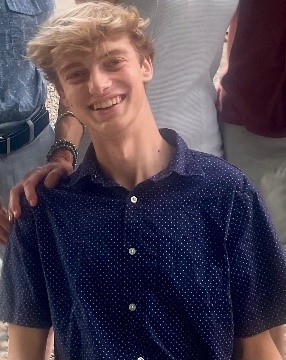
Bryce is 20 years old. He’s currently studying Sports Management at Miami University, is an active member of his fraternity and an avid Cleveland sports fan. He also has Stage 5 chronic kidney disease (CKD), and is in need of a kidney transplant.
At one year old, Bryce was diagnosed with CKD. His whole life he has managed medications, and endured frequent lab work, surgeries, and many doctor appointments. He has remained stable at Stage 3 CKD for the majority of his life. In 2020, Bryce graduated from Kenston High School and began his first year at Miami University. During this time, he unfortunately declined to Stage 4 CKD.
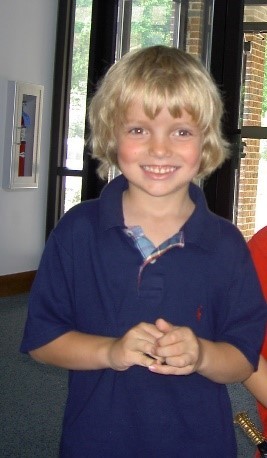
This July, his nephrologist informed him that his kidney function was drastically declining. He had entered Stage 5 CKD, or kidney failure. He began the testing required to be put on the transplant waitlist immediately.
The average time on the kidney transplant waitlist to receive a kidney from a deceased donor is 3-5 years. However, Bryce is hopeful he can receive a transplant from a living donor. A kidney from a living donor usually lasts longer and functions better, and the process can be much quicker.
Bryce’s mother and brother were both tested to donate their kidneys but are not matches, and their blood type is too rare to participate in a kidney swap (when a living kidney donor is incompatible with the recipient, an exchange can occur with another donor/recipient pair). His father only has one kidney so he is not eligible to be a donor.
In the state of Ohio, there are nearly 200 people Bryce’s age that are waiting for a kidney transplant. The thought of donating a kidney can seem overwhelming, but information can shed light on the process:
You only need one kidney to live a long healthy life.
The cost of the evaluation and surgery is covered by the recipient’s insurance.
Most donor surgery is done laparoscopically, meaning through a very tiny incision.
The recovery period for the donor is usually 2-4 weeks.
A separate team of healthcare professionals evaluates the living donor to inform them of the risks and benefits while looking out for their best interests.
If you’re considering becoming a living kidney donor, contact your local transplant center or the Kidney Foundation of Ohio for more information on the process.
UPDATE: Bryce received a living kidney donation in January of 2023. Him and the donor are both doing well. Read their story.
0 notes